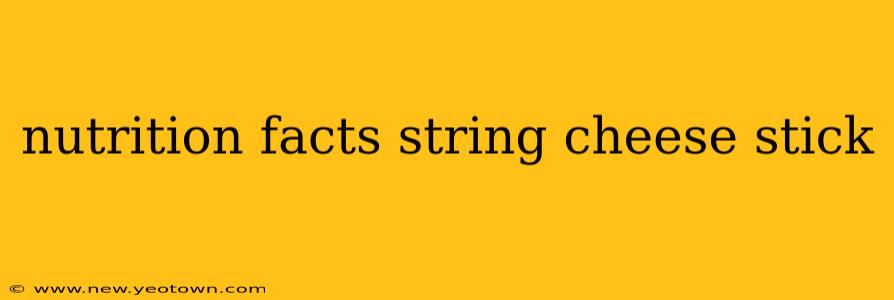String cheese. That quintessential childhood snack, the perfect after-school treat, the handy protein boost for busy adults. But beyond its convenient, pull-apart fun, what's truly in a string cheese stick? Let's unravel the nutritional secrets of this surprisingly wholesome snack.
My journey into the world of string cheese nutrition started with a simple question: what exactly am I eating? I’m a registered dietitian, and I've spent years educating people on healthy eating habits, so I felt I should know the nutritional breakdown of this ubiquitous snack. What I found was a surprising amount of variation, and much more than just cheese.
How Many Calories are in a String Cheese Stick?
This is the most frequently asked question, and the answer isn't a simple one-size-fits-all. The calorie count varies considerably depending on the brand, size, and type of cheese used. Generally, a single, standard string cheese stick (around 1 ounce) contains anywhere from 70 to 100 calories. Look carefully at the nutrition label! Larger sticks will, naturally, have a higher calorie count.
What is the Macronutrient Breakdown of String Cheese?
Let's break down the core components:
- Protein: String cheese is a fantastic source of protein, typically boasting around 6-8 grams per stick. Protein is essential for building and repairing tissues, keeping you feeling full and satisfied, and supporting overall health.
- Fat: The fat content varies, but it’s primarily saturated fat, which is important to consume in moderation. A typical stick will have between 4-7 grams of fat.
- Carbohydrates: Surprisingly low, string cheese contains only a trace amount of carbohydrates, usually less than 1 gram per stick. This makes it a great choice for those following low-carb diets.
- Calcium: String cheese is a great source of calcium, a vital mineral for strong bones and teeth. You can expect roughly 15-20% of your recommended daily intake of calcium in a single stick.
Is String Cheese Healthy? What are the Benefits?
With its impressive protein and calcium content, along with low carbohydrate count, string cheese ticks many healthy boxes. However, moderation is key. The benefits include:
- Portable Protein: Perfect for on-the-go snacking, string cheese provides a convenient and satisfying protein boost.
- Bone Health: The high calcium content contributes to strong bones and teeth.
- Muscle Growth and Repair: The protein supports muscle growth and repair, making it beneficial for athletes and active individuals.
- Satiety: The protein and fat content help to keep you feeling full and satisfied between meals, reducing the likelihood of overeating.
What are the Disadvantages of Eating String Cheese?
Despite its advantages, it’s important to acknowledge potential downsides:
- High Sodium: Some brands are high in sodium, so it's crucial to check the nutrition label and choose lower-sodium options.
- Saturated Fat: While fat is necessary, consuming too much saturated fat can negatively impact heart health. Moderation is essential.
- Additives and Preservatives: Some brands may contain additives and preservatives, so opting for natural or minimally processed options is advisable.
What are the Different Types of String Cheese?
The cheese used in string cheese varies, leading to differences in taste, texture, and nutritional content. You can typically find string cheese made from:
- Cheddar: A classic and popular choice, offering a sharp and tangy flavor.
- Mozzarella: Mild and creamy, mozzarella string cheese is a favorite among children and adults alike.
- Colby: A slightly sweeter and milder option compared to cheddar.
- Pepper Jack: A spicier option, not ideal for everyone.
Ultimately, the best way to understand the nutrition facts of your favorite string cheese is to carefully read the nutrition label on the packaging.
Disclaimer: I am a registered dietitian, and this information is for educational purposes only and should not be considered medical advice. Always consult with a healthcare professional or registered dietitian before making any significant dietary changes.

